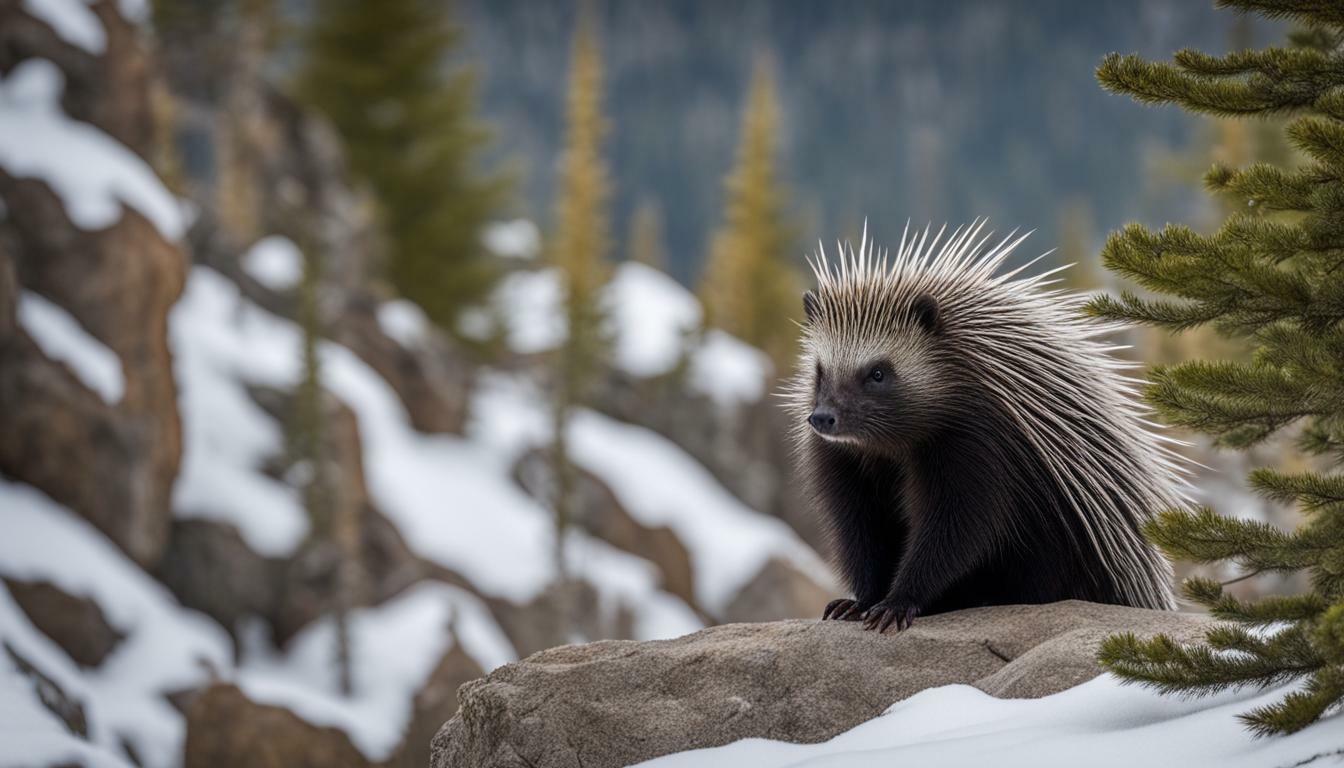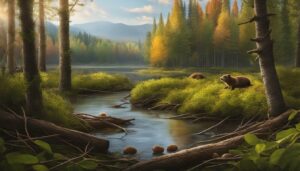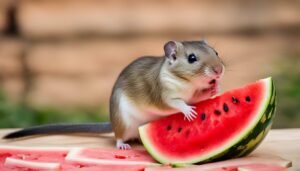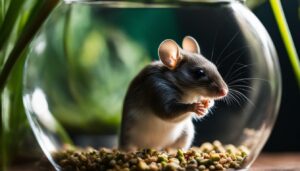If you’ve ever wondered if porcupines can be found in Colorado, the answer is a resounding yes. Colorado is home to these fascinating creatures, and they can be spotted in various habitats across the state. Porcupines in Colorado are primarily found in wooded and brushy areas, particularly in woodlands of ponderosa or pinyon pine. They can grow up to 33 pounds and have a distinct waddling gait, thanks to their long, yellowish guard hairs and dense coat of quills.
Porcupines are known for their quills, which serve as a deterrent to predators. While a threatened porcupine cannot throw its quills, these barbed quills easily stick to any animal or human that comes within striking distance. They have adapted to nest in rock shelters or trees and primarily feed on bark and herbs in their diet. These solitary animals come together to breed from November to December. However, they reproduce slowly and face threats from vehicles on roads.
Despite these challenges, porcupines have been making a gradual comeback in Colorado and have healthy populations in neighboring New Mexico. They are also known to occasionally consume bugs and small lizards, although their diet mostly consists of vegetation. Female porcupines carry their young for a gestation period of 16 to 31 weeks and give birth to one to three babies at a time, known as porcupettes.
Porcupettes are born with soft quills that harden in just a few days. They mature over a period of 9 months to 2.5 years and can live up to 15 years in the wild. With their unique characteristics and important role in Colorado’s wildlife, porcupines are a fascinating part of the state’s natural ecosystem.
Key Takeaways:
- Porcupines can be found in various habitats across Colorado, particularly in wooded and brushy areas.
- They have long, yellowish guard hairs and a dense coat of quills, which serve as a deterrent to predators.
- Porcupines primarily eat bark and herbs, but they may also consume insects and small lizards.
- They are solitary animals that come together to breed from November to December.
- Female porcupines carry their young for a long gestation period and give birth to one to three babies at a time, called porcupettes.
Porcupines’ Habitat in Colorado
Porcupines in Colorado are most commonly found in wooded and brushy habitats, with a preference for woodlands dominated by ponderosa or pinyon pine. These habitats provide the ideal environment for porcupines to thrive, as they offer ample sources of food and shelter. The trees in these woodlands provide a steady supply of bark, which makes up a significant portion of the porcupine’s diet. The dense vegetation and rocky terrain also provide ample hiding places and nesting sites for these solitary creatures.
Porcupines are well-adapted to their chosen habitats, with their long, yellowish guard hairs and dense coat of quills providing insulation against the elements. Their waddling gait is a result of their unique anatomy, which includes short legs and a stocky body. This allows them to navigate the rocky terrain and climb trees to access their preferred food sources.
“Porcupines are most common in woodlands of ponderosa or pinyon pine.”
In addition to their preference for specific types of woodlands, porcupines are also found in other wooded areas throughout Colorado. They can be seen in forests, high mountain meadows, and even in suburban areas with abundant vegetation. However, they are most abundant in the woodlands dominated by ponderosa or pinyon pine.
| Habitat Factors | Description |
|---|---|
| Vegetation | Woodlands with a steady supply of bark and herbaceous plants. |
| Shelter | Rocky terrain, trees, and other dense vegetation provide hiding places and nesting sites. |
| Preferred Trees | Ponderosa and pinyon pine are the dominant tree species in their preferred habitats. |
Porcupines’ habitat in Colorado is an essential factor in their population distribution. Understanding their preferred habitats helps researchers and conservationists develop appropriate strategies to protect these unique creatures and ensure their long-term survival.
Physical Characteristics of Colorado Porcupines
Colorado porcupines can grow to weigh up to 33 pounds and are recognized by their waddling gait, long yellowish guard hairs, and dense coat of quills. These quills, which are made of keratin, serve as the porcupine’s primary defense mechanism. When threatened, the porcupine raises its quills and turns its back toward the predator, making it difficult for the predator to attack without getting stuck. The barbs on the quills allow them to easily penetrate the skin of animals or humans that come into contact with them. Contrary to popular belief, porcupines do not throw their quills, but the quills can detach upon contact, embedding themselves into the predator’s flesh.
Porcupines in Colorado have a unique nesting behavior. They typically nest in rock shelters or tree dens, seeking protection from predators such as wolves, coyotes, and mountain lions. In terms of diet, porcupines are herbivores and specialize in consuming bark, leaves, and twigs. They are particularly fond of the bark of trees such as ponderosa or pinyon pine. Although vegetation forms the majority of their diet, porcupines may occasionally supplement it with insects or small lizards.
Porcupines in Colorado are solitary creatures, but they come together to breed during the months of November and December. Female porcupines have a gestation period of 16 to 31 weeks and give birth to one to three babies, known as porcupettes. These newborn porcupettes have soft quills that quickly harden within a few days of birth. Over time, porcupettes mature and develop their own set of defensive quills, which protect them from potential predators. The maturation process can range from 9 months to 2.5 years, depending on the individual porcupine.
| Physical Characteristics | Behavior |
|---|---|
| Grow up to 33 pounds | Solitary animals |
| Long yellowish guard hairs | Nest in rock shelters or trees |
| Dense coat of quills | Primarily eat bark and herbs |
| Barbed quills as defense | Breed from November to December |
| Quills detach upon contact | Soft quills harden in a few days |
| Diet occasionally includes insects and small lizards | Porcupettes mature in 9 months to 2.5 years |
Porcupine Behavior and Diet in Colorado
Porcupines in Colorado are solitary animals that build nests in rock shelters or trees, and their diet mainly consists of bark and various herbs. They are known for their slow gait and dense coat of quills, which serve as a deterrent to predators.
When it comes to behavior, porcupines are primarily nocturnal creatures, venturing out at night to forage for food. They are skilled climbers and can be found in wooded and brushy habitats, particularly in the woodlands of ponderosa or pinyon pine, where they can find ample food sources and protection.
Porcupines are highly specialized herbivores, with a preference for chewing on the inner bark of trees and consuming the tender shoots of various herbs. This diet provides them with the necessary nutrients and energy to sustain their slow-moving lifestyle. While they primarily rely on vegetarian fare, it is not uncommon for porcupines to occasionally consume insects and small lizards, especially when additional protein is needed.
“Porcupines are fascinating creatures that are perfectly adapted to their environment,” says wildlife expert Dr. Jane Thompson.
“Their solitary nature and unique diet make them an important part of the ecosystem in Colorado. However, it is essential to give them space and admire them from a distance to avoid any collisions with their quills.”
| Predominant Behavior | Habitat Preference | Primary Diet |
|---|---|---|
| Solitary | Rock shelters or trees | Bark and herbs |
Source: Colorado Wildlife Organization
Facts about Porcupines in Colorado:
- Porcupines are solitary animals that nest in rock shelters or trees.
- Their diet mainly consists of bark and various herbs.
- They occasionally consume insects and small lizards.
- Porcupines are most commonly found in the woodlands of ponderosa or pinyon pine in Colorado.
- They have a slow gait due to their long, yellowish guard hairs and dense coat of quills.
- Their quills serve as a deterrent to predators and can easily stick to any animal or human that comes within striking distance.
- Porcupines come together to breed from November to December.
- Female porcupines carry their young for a gestation period of 16 to 31 weeks.
- They give birth to one to three babies, called porcupettes, at a time.
- Porcupettes have soft quills that harden in a few days.
- Porcupettes reach maturity in 9 months to 2.5 years.
- Porcupines can live up to 15 years in the wild.
Porcupine Reproduction and Threats in Colorado
From November to December, porcupines in Colorado come together to breed, resulting in the birth of one to three babies, called porcupettes, after a gestation period of 16 to 31 weeks. These adorable porcupettes have soft quills that quickly harden within a few days, providing them with the same protection as their parents. Porcupines reproduce slowly, with females carrying their young for an extended period, ensuring the survival of their species in the wild.
While their slow reproduction rate is a challenge, porcupines in Colorado also face threats from vehicles on roads. As their habitats often overlap with urban areas, road accidents can be a significant cause of mortality among these unique creatures. To mitigate this risk, efforts are underway to raise awareness about the presence of porcupines in the state and implement measures such as wildlife crossings and speed limits in areas prone to porcupine crossings.
Despite these challenges, porcupines are making a gradual comeback in Colorado and can still be found in wooded and brushy habitats. They have healthy populations in neighboring New Mexico and are an integral part of the diverse wildlife in the region. Protecting their habitats and spreading knowledge about their behavior and needs will continue to play a vital role in safeguarding these fascinating creatures for future generations to enjoy.
Porcupine Quills and Defense Mechanisms
Porcupines in Colorado possess quills that act as a deterrent to predators, and while they cannot throw their quills, the barbed quills easily stick to anything that comes within striking distance. These quills are sharp and can cause considerable discomfort if they penetrate the skin. In fact, the quills have microscopic backward-facing barbs that make them difficult to remove once embedded. This defense mechanism serves as a warning to potential predators, as they quickly learn to avoid the sharp spines.
When threatened, a porcupine will raise its quills to appear larger and more intimidating. This display, combined with the rattling sound produced by the quills, acts as an additional warning to any would-be attacker. The quills themselves are covered in a waxy substance that helps to preserve their sharpness and protect against moisture. As a result, they are highly effective at deterring predators and reducing the risk of a porcupine being attacked.
Despite their formidable defense mechanisms, porcupines are not aggressive animals. They prefer to avoid conflict and will usually retreat to safety if given the opportunity. However, if a predator persists, the porcupine may attempt to back into the attacker, driving its quills deeper into the predator’s flesh. This can cause significant injury and discomfort, often leading the predator to abandon its pursuit.
Porcupines in Colorado: Fun Facts
- Porcupines have approximately 30,000 quills on their bodies.
- The quills are modified hairs and can reach lengths of up to 4 inches.
- Porcupines’ quills are hollow, which makes them lightweight yet stiff.
- Porcupines are excellent climbers and can maneuver through trees with ease.
- Their quills are easily shed and can take several months to regrow fully.
“Porcupines are fascinating creatures that have adapted impressive defense mechanisms to survive in their natural habitat. Their quills serve as both a visual warning and a potent deterrent to predators, ensuring their safety in the Colorado wilderness.” – Wildlife Expert
Porcupines’ quills and defense mechanisms are essential tools for their survival in the Colorado habitat. While these captivating creatures primarily rely on their natural defenses to ward off predators, they also play a crucial role in the ecosystem. As herbivores, porcupines help control vegetation growth and contribute to the overall balance of their environment. Their unique adaptations and behaviors make them a remarkable species to observe and admire in the wild.
| Porcupine Quills and Defense Mechanisms | |
|---|---|
| Fact: | Porcupines have approximately 30,000 quills on their bodies. |
| Fact: | The quills are modified hairs and can reach lengths of up to 4 inches. |
| Fact: | Porcupines’ quills are hollow, which makes them lightweight yet stiff. |
| Fact: | Porcupines are excellent climbers and can maneuver through trees with ease. |
| Fact: | Their quills are easily shed and can take several months to regrow fully. |
Porcupine Diet Variation and Adaptations
While porcupines in Colorado primarily feed on vegetation like bark and herbs, they may occasionally supplement their diet with insects and small reptiles. Their adaptation to a primarily herbivorous diet is reflected in their teeth, which are specialized for gnawing through tough plant material. Porcupines have strong incisors that continuously grow throughout their lives, allowing them to efficiently consume bark and other woody plant parts.
These herbivorous mammals have developed unique adaptations to thrive on a plant-based diet. For example, porcupines possess a specialized digestive system that enables them to extract as many nutrients as possible from their food. They have a large cecum, a pouch-like structure located at the beginning of the large intestine, which houses beneficial bacteria that aid in the digestion of cellulose, a complex carbohydrate found in plant cell walls.
Porcupines’ ability to consume insects and small reptiles, although less common than their plant-based diet, demonstrates their adaptability and opportunistic feeding behavior. This behavior may be influenced by factors such as seasonal availability of food or the need to supplement their nutritional intake. However, it is important to note that porcupines primarily rely on vegetation to meet their dietary requirements.
Table 1: Porcupine Diet Variation
| Diet | Frequency |
|---|---|
| Vegetation (bark, herbs) | Primary |
| Insects | Occasional |
| Small reptiles | Occasional |
In conclusion, porcupines in Colorado exhibit a primarily herbivorous diet, with bark and herbs comprising their main food sources. However, they are versatile feeders and may occasionally consume insects and small reptiles to supplement their nutritional intake. These dietary adaptations, along with their unique digestive system, allow porcupines to thrive in various habitats throughout Colorado’s woodlands and brushy areas.
Porcupine Life Cycle and Development
Newborn porcupines, known as porcupettes, have soft quills that gradually harden within a few days, and they reach maturity in 9 months to 2.5 years. These adorable creatures are born with their eyes open, fully covered in quills, and are capable of walking and climbing trees within hours of birth. Porcupettes rely on their mothers for protection and nourishment during their early stages of life.
As porcupettes grow, they start to explore their surroundings and develop their foraging skills. They closely follow their mothers, learning to forage for bark, twigs, leaves, and other vegetation that makes up the primary diet of adult porcupines. During this period, they also develop their quills, which serve as vital protection from predators.
With time, porcupettes inherit the solitary nature of their parents and become independent. This process can take anywhere from 9 months to 2.5 years, depending on the individual porcupine and the availability of resources in their habitat. Once they reach maturity, they are fully equipped to survive and reproduce, continuing the life cycle of porcupines in Colorado.
| Life Cycle Stage | Duration |
|---|---|
| Gestation Period | 16 to 31 weeks |
| Birth of Porcupettes | 1 to 3 babies |
| Maturity Age | 9 months to 2.5 years |
| Average Lifespan | Up to 15 years |
Porcupines in Colorado follow a slow reproductive rate, with limited offspring per pregnancy. This, coupled with threats from vehicles on roads, poses challenges to their population growth. However, conservation efforts are in place to protect porcupines, and they are gradually making a comeback in the state. Additionally, neighboring New Mexico boasts healthy porcupine populations, signifying their resilience and adaptability in different regions.
Porcupine Conservation in Colorado
Porcupines in Colorado face threats from road accidents, but conservation efforts are helping protect their population and ensure they thrive in their habitats. The state of Colorado has recognized the importance of preserving these unique creatures and has implemented various measures to safeguard their existence. One of the key initiatives is the creation of wildlife corridors and bridges that allow porcupines and other wildlife to safely cross busy roads.
In addition to infrastructure improvements, educational programs have been developed to raise awareness about porcupines and their habitat needs. These programs aim to educate the public about the importance of respecting wildlife and promoting coexistence. By understanding the behavior and needs of porcupines, people can take appropriate measures to minimize conflicts and ensure the survival of these fascinating creatures.
The efforts of conservation organizations and wildlife management agencies have also played a significant role in protecting porcupine populations in Colorado. These organizations work tirelessly to monitor and manage habitats, implement conservation plans, and conduct research to better understand the biology and ecology of porcupines. Through collaborative efforts, they strive to maintain healthy populations and preserve the biodiversity of the state.
| Conservation Measures for Porcupines in Colorado: |
|---|
| Creation of wildlife corridors and crossing structures |
| Educational programs to raise awareness |
| Collaboration with conservation organizations and agencies |
| Habitat monitoring and management |
| Research on porcupine biology and ecology |
With these dedicated conservation efforts in place, porcupines in Colorado have a better chance of thriving and coexisting alongside human populations. By protecting their habitats, reducing road accidents, and promoting responsible behavior, we can ensure the long-term survival of these captivating creatures in the state.
Porcupines’ Lifespan and Survival in the Wild
In the wild, porcupines in Colorado can live up to 15 years, relying on their unique adaptations and defensive mechanisms to survive. These captivating creatures possess a variety of traits that enable them to thrive in their natural habitat.
Porcupines are well-known for their quills, which act as a formidable deterrent against predators. When threatened, they raise their quills in an impressive display, warning any potential adversary to keep their distance. These quills are sharp and barbed, making it difficult for predators to remove them once embedded in their flesh. This exceptional defense mechanism helps porcupines ward off attacks and stay safe.
In addition to their defensive abilities, porcupines possess a remarkable ability to adapt to their environment. Their strong claws and muscular tails allow them to navigate through trees with ease, enabling them to access food sources and find secure locations for nesting. Porcupines are primarily herbivorous, consuming bark and various plant matter. However, they may occasionally indulge in insects and small lizards for added nutrition.
| Porcupines’ Lifespan | Adaptations and Survival Mechanisms |
|---|---|
| Up to 15 years |
|
Porcupines in Colorado face threats from vehicle collisions on roads, which can be detrimental to their populations. However, conservation efforts are in place to protect these unique creatures and promote their gradual recovery. It’s important to appreciate the role porcupines play in maintaining a balanced ecosystem, and their presence is a testament to the diverse wildlife found in Colorado.
Porcupines in Colorado vs. Other Regions
While porcupines in Colorado face certain challenges, they are making a gradual comeback in the state, and neighboring regions like Arizona and New Mexico have healthy porcupine populations. These resilient creatures have managed to adapt and thrive in their woodland and brushy habitats, particularly in the woodlands of ponderosa or pinyon pine.
Compared to other regions, Colorado provides suitable conditions for porcupines due to its diverse forested areas, providing ample food sources and shelter. This has contributed to their stable and growing population in the state. Porcupines have been observed nesting in rock shelters or trees, exhibiting their ability to adapt to various habitat types.
Porcupines in Colorado differ from those in other regions in terms of their natural habitat preferences. While they are most commonly found in woodlands, in other areas, they may inhabit a broader range of environments, including grasslands, deserts, and even mountainous regions. These adaptations allow them to be versatile in their choice of dwellings.
Comparison of Porcupine Populations in Colorado, Arizona, and New Mexico
| Region | Porcupine Population |
|---|---|
| Colorado | Stable and gradually increasing |
| Arizona | Making a gradual comeback |
| New Mexico | Healthy population |
As highlighted in the table above, porcupine populations in neighboring regions like Arizona and New Mexico are also thriving. These areas provide similar habitats for porcupines, allowing them to reproduce and sustain a healthy population. This indicates that the challenges faced by porcupines in Colorado are not insurmountable, and conservation efforts and habitat protection can contribute to their successful recovery.
In conclusion, while porcupines in Colorado face certain challenges, they are making a gradual comeback in the state. Neighboring regions like Arizona and New Mexico also boast healthy porcupine populations, showcasing the adaptability and resilience of these unique creatures. Conservation efforts and habitat preservation play a vital role in ensuring the long-term survival of porcupines in Colorado and beyond.
Conclusion
Porcupines have firmly established themselves as residents of Colorado’s diverse habitats, contributing to the rich wildlife of the Rocky Mountains. These unique creatures can be found in wooded and brushy environments, particularly in woodlands of ponderosa or pinyon pine.
Colorado porcupines are known for their distinct physical characteristics, including their waddling gait caused by long, yellowish guard hairs and a dense coat of quills. While a threatened porcupine cannot throw its quills, these barbed defensive mechanisms easily attach to any animal or human that comes within striking distance.
These solitary animals nest in rock shelters or trees and primarily feed on bark and herbs. Their slow reproduction rate and threats from road accidents pose challenges to their population, but conservation efforts have led to a gradual comeback in Colorado and healthy populations in neighboring New Mexico.
Porcupines are renowned for their quills, which serve as a deterrent to predators. Although they mainly consume vegetation, they may occasionally indulge in insects and small lizards. Female porcupines carry their young for a gestation period of 16 to 31 weeks and give birth to one to three babies at a time. These newborns, called porcupettes, have soft quills that harden in just a few days. Within 9 months to 2.5 years, porcupettes mature into adults and can live up to 15 years in the wild.
FAQ
Are porcupines found in Colorado?
Yes, porcupines are found in Colorado, particularly in wooded and brushy habitats.
What types of habitats do porcupines prefer in Colorado?
Porcupines are most common in woodlands of ponderosa or pinyon pine in Colorado.
How big can porcupines in Colorado grow?
Porcupines in Colorado can grow up to 33 pounds in weight.
What is the behavior of porcupines in Colorado?
Porcupines in Colorado are solitary animals and primarily eat bark and herbs.
How do porcupines defend themselves in Colorado?
Porcupines in Colorado have quills that serve as a deterrent to predators. While they cannot throw their quills, the barbed quills easily stick to any animal or human that comes within striking distance.
How do porcupines reproduce in Colorado?
Porcupines in Colorado come together to breed from November to December. Females carry their young for a gestation period of 16 to 31 weeks and give birth to one to three babies at a time.
How long do porcupettes take to mature in Colorado?
Porcupettes in Colorado mature in 9 months to 2.5 years.
What is the average lifespan of porcupines in the wild in Colorado?
Porcupines in the wild in Colorado can live up to 15 years.




